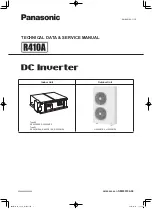
24
5.3.5
Bending
piping
Bending
copper
piping
reduces
the
number
of
brazed
joints
required
and
can
improve
quality
and
save
material.
5.4
Refrigerant
Piping
Supports
When
the
air
conditioning
is
running,
the
refrigerant
piping
will
deform
(shrink,
expand,
droop).
To
avoid
damage
to
piping,
hangers
or
supports
should
be
spaced
as
per
the
criteria
in
the
Table
3
‐
5.2.
In
general,
the
gas
and
liquid
pipes
should
be
suspended
in
parallel
and
the
interval
between
support
points
should
be
selected
according
to
the
diameter
of
the
gas
pipe.
Suitable
insulation
should
be
provided
between
the
piping
and
the
supports.
If
wooden
dowels
or
blocks
are
to
be
used,
use
wood
that
has
undergone
preservative
treatment.
Changes
in
refrigerant
flow
direction
and
refrigerant
temperature
result
in
movement,
expansion
and
shrinkage
of
the
refrigerant
piping.
Piping
should
therefore
not
be
fixed
too
tightly,
otherwise
stress
concentrations
may
occur
in
the
piping,
with
the
potential
for
rupturing.
Table
3
‐
5.2:
Refrigerant
piping
support
spacings
Pipe
(mm)
Interval
between
support
points
(m)
Horizontal
Piping
Vertical
Piping
<
Ф
20
1
1.5
Ф20
–
Ф
40
1.5
2
>
Ф
40
2
2.5
Piping
bending
methods
Hand
bending
is
suitable
for
thin
copper
piping
(Ф6.
35mm
‐ Ф
12.
7mm).
Mechanical
bending
(using
a
bending
spring,
manual
bending
machine
or
powered
bending
machine)
is
suitable
for
a
wide
range
of
diameters
(Ф6.
35mm
‐ Ф
54.0mm).
Caution
When
using
a
spring
bender,
ensure
that
the
bender
is
clean
before
inserting
it
in
the
piping.
After
bending
a
copper
pipe,
ensure
that
there
are
no
wrinkles
or
deformation
on
either
side
of
the
pipe.
Ensure
that
bend
angles
do
not
exceed
90°,
otherwise
wrinkles
may
appear
on
the
inner
side
of
the
pipe,
and
the
pipe
may
buckle
or
crack.
Refer
to
Figure
3
‐
5.3.
Do
not
use
a
pipe
that
has
buckled
during
the
bending
process;
ensure
that
the
cross
section
at
the
bend
is
greater
than
2/3
of
the
original
area.
Figure
3
‐
5.3:
Pipe
bending
in
excess
of
90
°
Notes
for
installers
Wrinkles
may
appear
















































